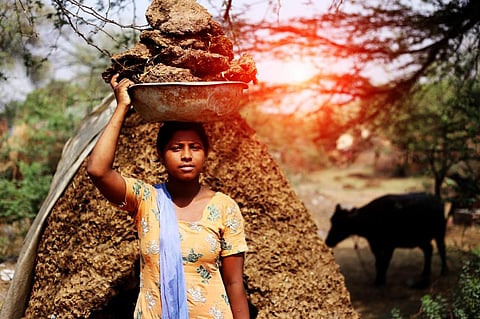Organic fertiliser: A must for the next green revolution
India's growth story on the path of economic reforms has transformed the country into one of the fastest-growing economies in the world.
Despite having an enormous opportunity, India has been unable to capitalise on its strengths.
The central government has announced schemes worth crores for various sectors. Similar steps need to be undertaken for the organic fertiliser industry, as India has the potential to become the hub of organic fertiliser production in the world.
Organic fertiliser can be categorised into two segments, according to government rules: Bio-fertiliser and organic manure.
Bio-fertilisers are composed of living microorganisms attached to solid or liquid carriers and are useful for cultivable land, as these micro-organisms help in increasing the productivity of soil and / or crops.
Organic manure, on the other hand, refers to partially decomposed organic matter like digestate from a biogas plant, compost and vermicompost, which provides nutrients to the soil / crops and improves yield.
India produces more than 150,000 tonnes of municipal solid waste (MSW), based on estimated MSW generation data from the National Solid Waste Association of India and the Central Pollution Control Board.
Considering collection efficiency of 80 per cent and organic part of MSW to be 50 per cent, total organic waste generated per day in India comes to around 65,000 tonnes per day.
Even if half of this is diverted to the biogas industry, the government can leverage this by reduction in import of fossils and fertilisers.
Biogas / gobar gas plants not only produces biogas but also organic fertilisers. There is also great value in the organic fertiliser also known as digestate, which is the biogas plant's effluent.
Biogas can be utilised for heating, electricity and even vehicular purposes (after upgrading), whereas digestate can help realise the vision to have a second green revolution.
Digestate can provide organic carbon to the continuously depleting soil, apart from its standard nutrition value. In India at present, bio-fertiliser production is just over 110,000 tonnes ( carrier-based 79,000 tonnes and liquid-based 30,000 tonnes) and 34 million tonnes of organic manure, composed of farmyard manure, city compost and vermicompost, among others.
The organic manure (digestate) from a biogas plant can be applied at the rate of around 40 tonnes per hectare of cultivable land.
The penetration of organic fertilisers is low: The proportion of organic fertilisers of the overall fertiliser consumption was only 0.29 per cent for 2018-19 and 0.34 per cent for 2019-20. With promotion of biogas production, the government can reap the benefits of its bi-product — fertiliser.
The Centre has shown the intent of promoting the industry through its SATAT scheme. It has no doubt allocated 468 crores towards Central Financial Assistance in the earlier budget. But the industry needs much more support to save the future governments billions of dollars, because if all the projects applied under SATAT scheme materialise, it will help the country save $16 billion year-on-year.
Bio-compressed natural gas (bio-CNG) and solid organic manure or digestate can be produced in large quantities under the SATAT programme, under which more than 5,000 projects have been targeted across the country by the industry.
Thus, considering 8,000 kilogram / day of bio-CNG (one tonne of CNG can cater to 100 vehicles to run 250 kilometre per full tank of 10 kilogram at the rate of 25 kilometre / kilogram) and 27 tonnes / day of solid organic manure per plant with average plant size assumed to be 8 tonnes per day, it was estimated that 50 million tonnes per annum of solid organic manure / digestate will be generated in India once these projects are installed.
The popularity of organic farming has grown in the domestic market in recent years. The market size for Indian organic packaged food is expected to grow at a rate of 17 per cent and cross Rs 871 million by 2021.
The significant rise of this sector is linked to growing awareness about the harmful effects of synthetic fertiliser on soil, rising health concerns, expanding urban population base and an increased consumer expenditure on food goods.
Because organic manure can be improved with the use of bio fertilisers to meet nutrient requirements, both bio fertilizers and organic manure have the potential to eliminate the usage of synthetic fertilisers completely.
AR Shukla is the president of Indian Biogas Association.
Views expressed are the author’s own and don’t necessarily reflect those of Down To Earth.

